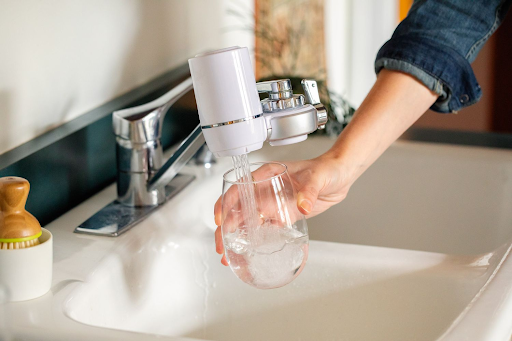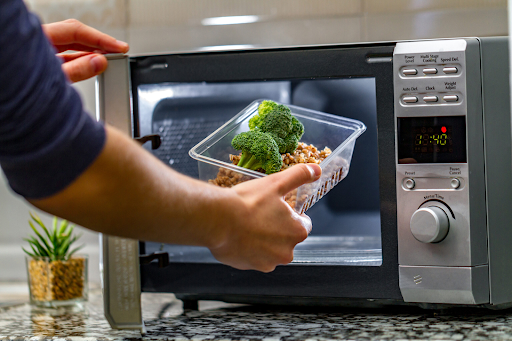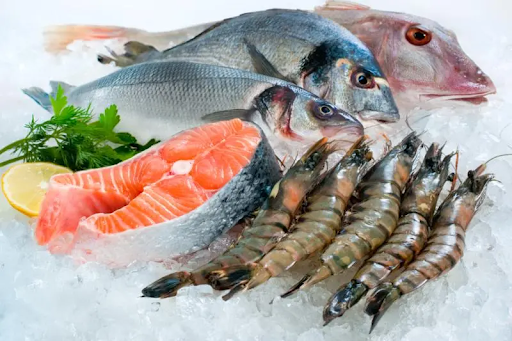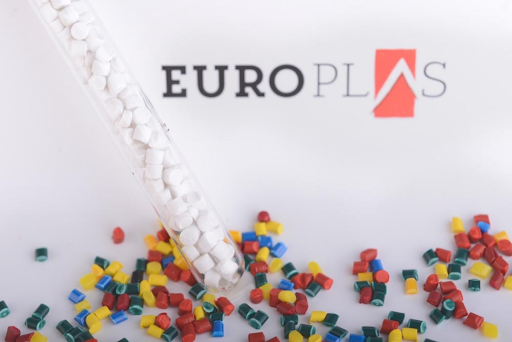Microplastics, tiny particles less than 5 millimeters in size, are pervasive, and they have found their way into our food chain. The consequences of ingesting these particles are still being studied, but the potential risks cannot be ignored. Fortunately, there are proactive steps we can take to protect ourselves and the planet. This article explores practical and how to avoid microplastics in food, ensuring a healthier, more sustainable future for all.
1. Foods have the most microplastics
1.1 Seafood
Seafood, a delicacy loved by most people, is also a worrying source of microplastic exposure. Seafood such as squid, scallops, and shrimp have the ability to absorb microplastics from the seawater environment during the process of living and growing.
Research shows that microplastics can be present at significant levels in some types of seafood, depending on where they are raised, caught, or processed. This may raise concerns about the impact of microplastics on human health when consuming these seafood products. Seafood consumed without proper gut removal is more likely to contain higher levels of microplastics.
1.2. Fruits and vegetables
Recent studies have shed light on the pervasive presence of microplastics in our food, raising concerns about the potential health risks associated with their consumption. Fruits and vegetables once celebrated as essential components of a healthy diet, are now under scrutiny.
Apples, in particular, have come under the spotlight, with an alarming average of 195,500 plastic particles per gram. Pears follow closely behind, averaging around 189,500 plastic particles per gram. Broccoli and carrots, staple vegetables in many households, have also been identified as highly contaminated.
1.3. Other foods and beverages
Additionally, microplastics have been found in other foods and beverages such as salt, honey, rice, sugar, beer, and even bottled water. Plastic packaging, processing, and transportation methods can introduce microplastics into these products.
Read more:
Microplastic: the unseen threat to our oceans and planet
2. How to avoid microplastics in food
2.1. Filter your tap water or drink water from a good source

Filter your tap water can help to avoid microplastics
To avoid microplastics in food, choosing between filtering tap water and opting for water from a reliable source plays a pivotal role. Filtering tap water provides a practical solution, as it eliminates potential microplastic contaminants that might find their way into our drinking water through various environmental factors. By investing in a high-quality water filtration system, you can rest assured that your family's drinking water source does not contain harmful microplastics, contributing to ensuring the best health.
On the other hand, selecting water from a trustworthy natural source, such as springs or wells, can be a viable option. Such sources often boast pristine water quality, minimizing the risk of microplastic contamination and offering a refreshing, natural alternative. Both choices emphasize the significance of conscious decision-making, promoting clean water consumption to safeguard ourselves from the potential hazards of microplastics in our food.
2.2. Use environmentally friendly bottles, packaging bags, and clothing materials
Using eco-friendly bottles made of materials such as glass or stainless steel is indeed a good way to reduce the risk of microplastic contamination in beverages. Both glass and stainless steel are non-toxic, reusable, and recyclable materials, making them environmentally friendly alternatives to single-use plastic bottles.
Instead of using single-use plastic bags, carry reusable cloth bags when you go shopping. Many stores now offer reusable bags, and they are durable and can be used multiple times. When purchasing clothes, choose natural fibers like cotton, linen, or wool over synthetic fibers. Synthetic fabrics like polyester release microplastics when washed, which can end up in the oceans.
By choosing these options, you not only minimize your exposure to microplastics but also contribute to reducing plastic pollution and promoting sustainability.
2.3. Do not microwave food in plastic containers

You shouldn’t use plastic containers when microwaving food
Microwaving food in plastic containers can potentially lead to the release of harmful chemicals, including microplastics, into the food. When plastic containers are exposed to heat, especially in a microwave, they can break down and release microplastic particles and other chemicals. This process happens even faster when you use old, scratched, or worn plastic containers.
To avoid microplastics in food, it is advisable to use microwave-safe glass or ceramic containers instead of plastic ones. Glass and ceramic containers do not leach harmful chemicals or microplastics, ensuring that your meals remain free from these contaminants. Doing these simple activities in your kitchen habits can significantly reduce the risk of ingesting microplastics and other potentially harmful substances with your food.
2.4. Be cautious with seafood

Be careful when choosing seafood for your meals to avoid microplastics
These marine organisms often mistake microplastic particles for food, eat them, and then become human food. When humans consume contaminated seafood, they can indirectly ingest these microplastics, which may have adverse health effects.
To avoid microplastics in seafood, it is recommended to:
- Carefully clean and prepare seafood before cooking: Wash seafood thoroughly under clean water to remove any impurities, including microplastics. Remove the digestive tract and abdomen of the seafood, where plastic particles may be concentrated. For seafood such as scallops or oysters, carefully remove all non-meat parts.
- Choose to buy seafood from reputable places: Priority should be given to choosing to buy seafood from reputable and quality sources, where there are high standards of food management and safety.
- Select smaller fish: Smaller fish lower on the food chain, such as sardines and anchovies, tend to accumulate fewer microplastics compared to larger predatory fish.
- Avoid using plastic packaging to package and transport seafood: Plastic packaging can lead to contamination if it comes into contact with seafood.
- Be careful about the origin: Always be clear about the origin of the seafood you consume.
2.5. Mind your tea bags
Traditional paper tea bags are biodegradable and safe to use. However, certain modern tea bags are made with plastic-derived materials, like nylon or polypropylene, to help them retain their shape during steeping. When these plastic-based tea bags are steeped in hot water, they can release microplastics into the tea, which can be ingested when the tea is consumed.
To avoid microplastics in your tea, consider the following:
- Choose loose-leaf tea: Opt for loose-leaf tea or tea sachets made from natural, biodegradable materials. Loose-leaf tea gives you delicious cups of tea without the risk of plastic contamination.
- Check the label: Read the packaging or label of tea bags to ensure they are made from natural fibers like paper, cotton, or silk. Avoid tea bags made with plastic or nylon materials.
- Use a tea strainer: If you prefer using tea bags, invest in a reusable tea strainer made from stainless steel, silicone, or other non-plastic materials. The tea filter keeps the carved tea leaves out of the water when steeped in hot water, providing a delicious cup of tea and you don't need to worry about microplastic particles getting mixed into the tea.
3. Conclusion
In the ongoing journey to protect our health and our planet, how to avoid microplastics in food becomes increasingly important. The above sharing section discusses specific and practical measures to minimize the risk of exposure to these toxic substances when consuming everyday foods. We, each of us, join hands to contribute to the common goal of keeping food safe and free from contamination by microplastics. Let's act now to build a healthy and sustainable future for ourselves and the next generation.
4. EuroPlas and environmentally friendly bioplastic products
As the leading filler masterbatch manufacturer globally, EuroPlas takes great pride in providing customized plastic material solutions to best support customers and enhance the competitive advantage of plastic businesses. Our customer-centric approach is the foundation for our development, therefore, EuroPlas is always dedicated to meeting customer needs and ensuring the highest satisfaction. At EuroPlas, we offer a diverse range of products tailored to the varied demands of the global plastic market, including color masterbatch, plastic additives, engineering plastic compound, filler masterbatch, etc.

EuroPlas has diverse products for the needs of plastic businesses in the world
EuroPlas recognizes the importance of harmonizing enterprise, society, and the environment for sustainable development. Through practical research, we have introduced biological raw material solutions to the world plastic market, helping plastic businesses improve quality, reduce production costs, and minimize environmental impact. Two notable products in our portfolio include:
- Bioplastic compound: Our BiONext bioplastic compounds stand out due to their biodegradability. Finished products made from BiONext can easily decompose into water, CO2 gas, and biomass within just 12 months after disposal. This biomass can further be utilized as agricultural fertilizer, creating a complete circular life cycle for the product. This is a product that is consistent with our commitment to sustainable development, in which production, consumption, and waste treatment are all friendly to the environment and ecosystems.
- Biofiller: BiOMates, our biodegradable filler made from bioplastic, is an excellent choice for eco-conscious products like biodegradable packaging, injection molding, and single-use plastic extrusion items.
Generally, at EuroPlas, we continue to innovate and advance, ensuring our products contribute to a more sustainable and environmentally friendly future for industries worldwide. Contact us now to learn more about our products and choose those that are suitable for your requirements.